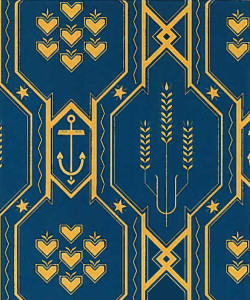Designed and produced for the United Nations Security Council Chamber, this textile is one of the most culturally significant wallcoverings acquired by the museum. The material was used to cover the walls and for draperies in the United Nation’s first permanent quarters in New York City. Following a period of great international turmoil the Security Council Chamber was gifted to the United Nations by Norway, and since 1952 has been the meeting place for world leaders to come together to unite their strength in order to maintain peace and security.
 This sample is a small section of the complete design which contains symbolic motifs including anchors of faith, growing wheat of hope, and hearts of charity. The fabric is a rayon satin damask produced by Joh. Petersen AS in Oslo, Norway. While none of the fabric originally installed in the chamber remains, this is an unused piece of the 1951 fabric given to the mill by a former employee, and gifted to the Cooper Hewitt by the Petersen family and Royal Norwegian Consulate General.
This sample is a small section of the complete design which contains symbolic motifs including anchors of faith, growing wheat of hope, and hearts of charity. The fabric is a rayon satin damask produced by Joh. Petersen AS in Oslo, Norway. While none of the fabric originally installed in the chamber remains, this is an unused piece of the 1951 fabric given to the mill by a former employee, and gifted to the Cooper Hewitt by the Petersen family and Royal Norwegian Consulate General.
The Security Council Chamber was designed by Arnstein Arneberg, one of Norway’s most renowned modernist architects, and the fabric used for the wallcovering and draperies was designed by Norwegian textile artist Else Poulsson. While conveying messages of peace, justice, and democracy the Security Council Chamber is representative of mid-century Norwegian art and culture. The focal point of the chamber is a large mural painted by Per Krohg which depicts a phoenix rising from the ashes of violence and struggle, symbolic of the creation of the United Nations following the destruction of World War II. The Poulsson fabric frames this mural and extends to the rear of the chamber, where the wall is covered with a more neutral straw wallcovering.
